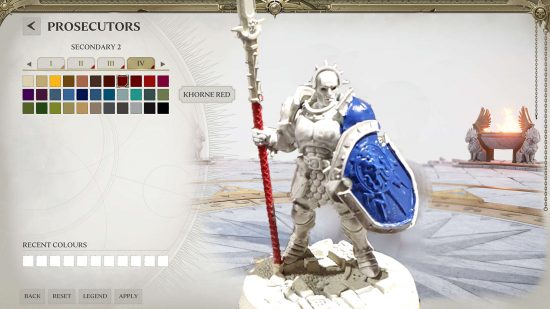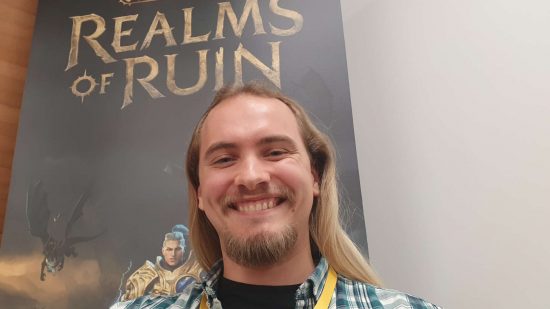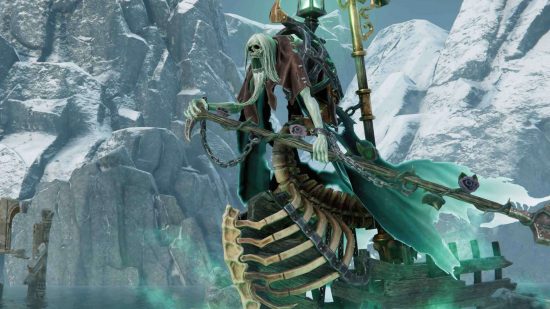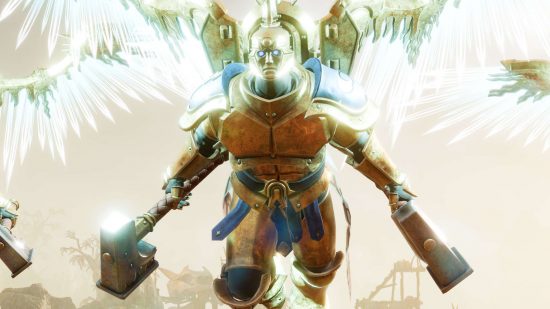There are worse ways to conduct an interview than painting Warhammer figures. That’s how Wargamer’s interview with Warhammer Realms of Ruin single-player campaign designer Daniel Saunders begins, with paintbrush in hand at a press event hosted at Game’s Workshop’s Warhammer World visitor centre in Nottingham, UK.
Saunders has been working on Realms of Ruin since January 2022, but he’s been part of the Warhammer fandom for much longer. “I grew up on Dawn of War”, he says, “And then I had a Warhammer 40k starter set, I think it was ‘Assault on Black Reach’”. He took up Warhammer Age of Sigmar not long before joining the development team, “which was good timing!”
Saunders and I, plus plenty of journalists from other outfits, are painting miniatures as if it was our first paint-and-take taster session in a Warhammer store, with helpful Warhammer World staff chiming in to give advice. Saunders gets stuck in painting a white and blue Knights Excelsior Stormcast Eternals Liberator.
“My main army is Disciples of Tzeentch”, he says. “I’ve been absolutely bursting to talk about them in Realms of Ruin since I first learnt they were going to be in the game”.
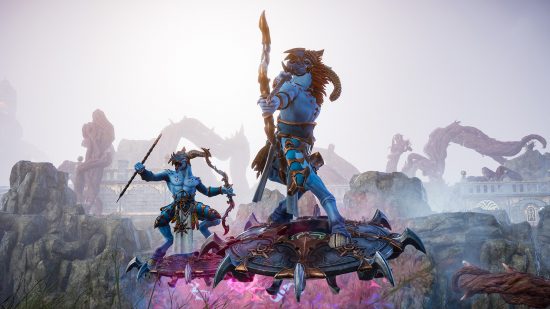
Saunders was hired as a generalist game designer, with the bulk of his role contributing to the game’s single-player campaign. “It falls within mission design, level design, plus a little technical work making tools for the team”. He’s in high spirits. “The game is done, now. We’re just waiting for launch”.
Single-player campaigns in RTS games have to teach players a fat stack of game mechanics, and then the strategy players will need to actually succeed in missions. Saunders explains how the mission structure of Realms of Ruin is designed to support that; “The first two missions teach you the basics of using the Stormcast, summoning units, capturing points, but then mission three says: show us what you learned”.
Wargamer got to preview mission three at an earlier event; it plays like a trimmed-down multiplayer match, the scope limited to just the first tier of units and abilities which players will already be familiar with. “That structure is used throughout the campaign”, Saunders adds.
Saunders says “We went into production knowing we had to do something to teach players”, but the rhythm of missions that teach, teach, then test the player, “was developed while we were in the field”. He adds that “lots of missions have been through multiple iterations to get our ideas and execution aligned”.

The other big challenge for a single player RTS is to deliver the game’s narrative effectively. Saunders says the mission design team “received a story treatment, which is a list of all the narrative beats that have to occur in each section” from the narrative leads, but the team was then free to integrate those story beats alongside the gameplay as they saw fit.
He elaborates: “In the first level there were characters we needed to introduce, and we had to set the scene, introduce the Stormcast as these heroic, angelic, powerful agents of Order, and Ghur as this bestial, terrifying, realm”. All of which had to be incorporated into an effective set of tutorial objectives that would teach players how to use the game.
Saunders tells us that the multiple faction perspectives in the narrative allow the campaign to introduce all the factions effectively. “You’ll play so many levels as one faction, learning all the units in a tier, and then the story switches to another faction”.
These switches may also put you up a level of complexity and increase the tech cap. “The goal is to ensure a satisfying difficulty curve, while helping you learn how to play with each faction”.
In the second part of our interview, we ask Saunders about the influence of the classic Relic RTS Dawn of War on Realms of Ruin. With the Realms of Ruin release date fast approaching, make sure you check out Wargamer’s Realms of Ruin review.
